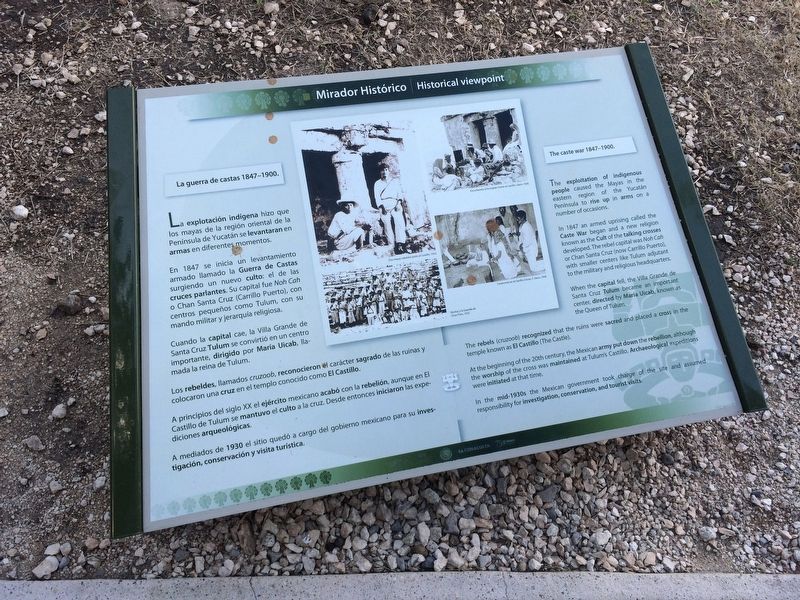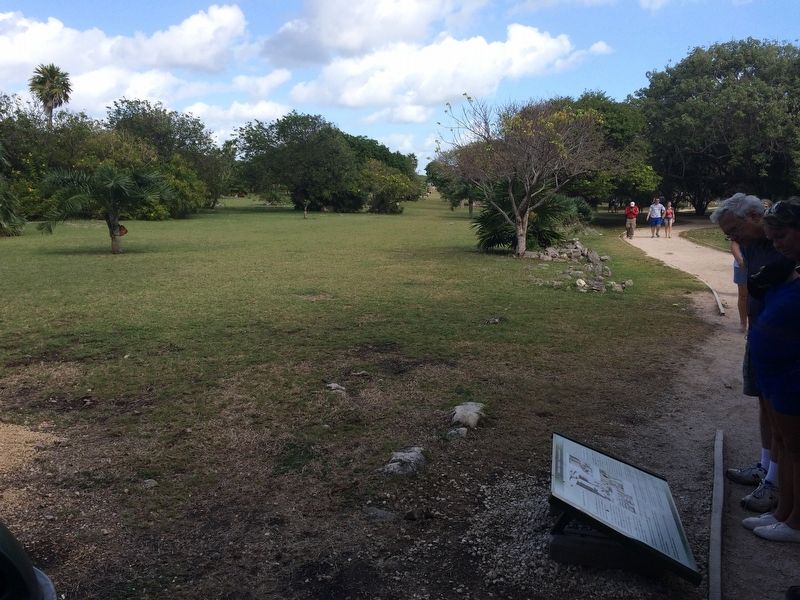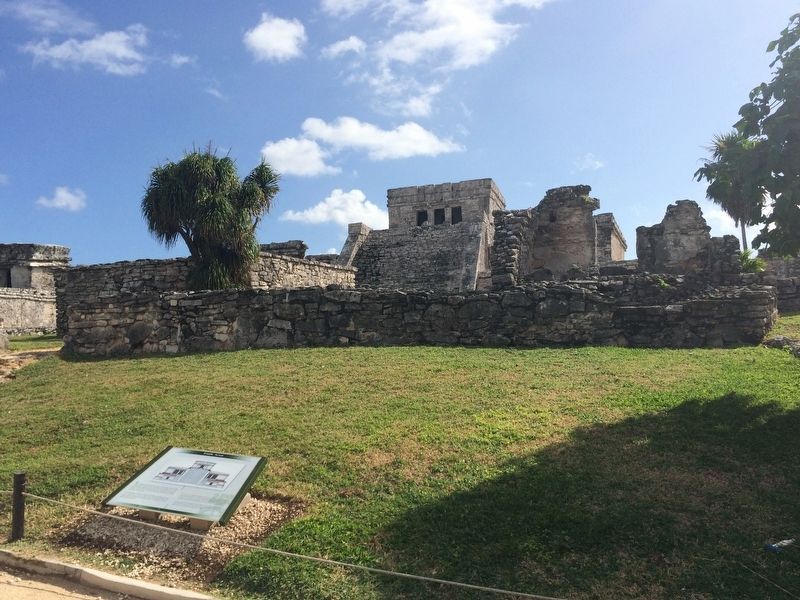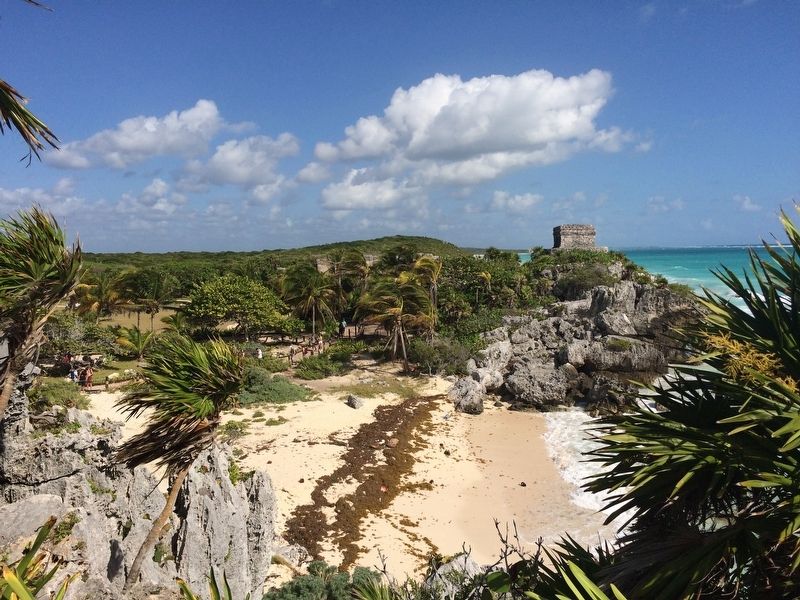Tulum, Quintana Roo, Mexico — The Yucatan Peninsula (The Southeast)
The Caste War 1847-1900
Mirador Histórico / Historical viewpoint
La guerra de castas 1847-1900.
La explotación indígena hizo que los mayas de la región oriental de la Península de Yucatán se levantaran en armas en diferentes momentos.
En 1847 se inicia un levantamiento armado llamado la Guerra de Castas surgiendo un nuevo culto: el de las cruces parlantes. Su capital fue Noh Cah o Chan Santa Cruz (Carillo Puero), con centros pequeños como Tulum, con su mando militar y jerarquía religiosa.
Cuando la capital cae, la Villa Grande de Santa Cruz Tulum se convirtió en un centro importante, dirigido por María Uicab, llamada la reina de Tulum.
Los rebeldes, llamados cruzoob, reconocieron el carácter sagrado de las ruinas y colocaron una cruz en el templo conocido como El Castillo.
A principios del siglo XX el ejército mexicano acabó con la rebelión, aunque en El Castillo de Tulum se mantuvo el culto a la cruz. Desde entonces iniciaron las expediciones arqueológicas.
A mediados de 1930 el sitio quedó a cargo del gobierno mexicano para su investigación, conservación y visita turística.
Pie de dibujos:
Dos mayas rebeldes junto al Castillo, 1922.
Escuchando el fonógrafo frente al Castillo. Gann, 1926.
Morley y la Guardia de Chun Pom, 1922.
Ceremonia en el Castillo Tulum, T. Gann, 1926.
English:
The caste war 1847-1900.
The exploitation of indigenous people caused the Mayas in the eastern region of the Yucatán Peninsula to rise up in arms on a number of occasions.
In 1847 an armed uprising called the Caste War began and a new religion known as the Cult of the talking crosses developed. The rebel capital was Noh Cah or Chan Santa Cruz (now Carillo Puerto), with smaller centers like Tulum adjutant to the military and religious headquarters.
When the capital fell, the Villa Grande de Santa Cruz Tulum became an important center, directed by María Uicab, known as the Queen of Tulum.
The rebels (cruzoob) recognized that the ruins were sacred and placed a cross in the temple known as El Castillo (The Castle).
At the beginning of the 20th century, the Mexican army put down the rebellion, although the worship of the cross maintained at Tulum’s Castillo. Archaeological expeditions were initiated at that time.
In the mid-1930s the Mexican government took charge of the site and assumed responsibility
for investigation, conservation, and tourist visits.
English translation of captions:
Two maya rebels next to El Castillo, 1922.
Listening to the phonograph in front of El Castillo. Gann, 1926.
Morley and the guards of Chun Pom, 1922.
Ceremony in El Castillo Tulum, T. Gann, 1926.
Erected by Consejo Nacional para la Cultura y las Artes de México (CONACULTA).
Topics. This memorial is listed in these topic lists: Anthropology & Archaeology • Native Americans • Wars, Non-US.
Location. 20° 12.796′ N, 87° 25.825′ W. Marker is in Tulum, Quintana Roo. Memorial can be reached from Carretera Cancún - Tulum (Route 307). The marker is at the far south of the Tulum Archaeological Site near the town of Tulum, near the exit of the walled site. Touch for map. Marker is in this post office area: Tulum QR 77700, Mexico. Touch for directions.
Other nearby markers. At least 6 other markers are within walking distance of this marker. The Temple of the Stela (about 180 meters away, measured in a direct line); The Castle (about 180 meters away); Temple of the Descending God (about 240 meters away); The Palace of the Great Lord (approx. 0.2 kilometers away); Trade and Navigation (approx. 0.3 kilometers away); The House of the Cenote (approx. 0.4 kilometers away).
Also see . . .
The Caste War. The Caste War of the Yucatán was an armed struggle of the indigenous Maya against the landed elite that continued for more than 50 years, with an estimated 40,000 – 50,000 people dying in the hostilities. (Submitted on March 1, 2017, by J. Makali Bruton of Accra, Ghana.)
Credits. This page was last revised on March 1, 2017. It was originally submitted on March 1, 2017, by J. Makali Bruton of Accra, Ghana. This page has been viewed 211 times since then and 5 times this year. Photos: 1, 2, 3, 4. submitted on March 1, 2017, by J. Makali Bruton of Accra, Ghana.



